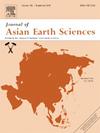Revealing new perspectives from vintage data using cutting-edge seismic imaging: An example from the deep-water Krishna-Godavari Basin, India
IF 2.7
3区 地球科学
Q2 GEOSCIENCES, MULTIDISCIPLINARY
引用次数: 0
Abstract
In this study, we present a novel insight by reprocessing a legacy 3D deep-marine seismic dataset. We leveraged all aspects of the recorded wavefield from the legacy data, extracting valuable information to understand the complex subsurface through a multifaceted approach. We developed an efficient algorithm using direct arrivals and nonlinear refraction tomography to rectify the inherent anomalies in the geometry definition. Time-shift adjusted adaptive subtraction was adopted to optimally suppress multiples from the pre-stack wavefield. Through interpretative velocity analysis, geological layer consistencies were incorporated into the velocity model, which was further refined with reflection tomography and waveform inversion to enhance the resolution of the interval velocity field and improve the image within the complex structures. Local-angle domain wavefield separation migration was used to separately image the diffractions and also improve the continuity of the specular stacks. A novel application of tensor-based structure-oriented filtering attenuated the remnant multiples from the final stack. The final images indicate potential targets for hydrocarbon exploration. Intricate toe-thrust structures were revealed that were completely obscured in the legacy stacks, potentially highlighting an entirely new geological perspective. The study also indicates the presence of possible gas hydrates on fracture-filled host rocks, which strongly correlates with the findings of previous studies. Through this study, we justify the enduring value of the vintage datasets and the necessity of revisiting the same with advanced imaging technologies and optimal computational resources to generate fresh perspectives, unlock new prospects, and maintain sustainable exploration practices.

利用先进的地震成像技术从古数据中揭示新的视角:以印度克里希纳-戈达瓦里盆地深水为例
在这项研究中,我们通过对传统的三维深海地震数据集进行再处理,提出了一种新的见解。我们从遗留数据中利用记录波场的各个方面,提取有价值的信息,通过多方面的方法了解复杂的地下情况。我们开发了一种有效的算法,使用直接到达和非线性折射层析成像来纠正几何定义中的固有异常。采用时移调整自适应减法,对叠前波场的倍数进行了最优抑制。通过解释速度分析,将地质层序一致性纳入速度模型,再通过反射层析成像和波形反演对速度模型进行细化,提高了层间速度场的分辨率,改善了复杂构造内部的成像效果。采用局角域波场分离偏移对衍射进行了分离成像,提高了镜面叠加的连续性。一种基于张量的面向结构滤波的新应用减弱了最终堆栈的残余倍数。最终的图像显示了油气勘探的潜在目标。复杂的脚趾逆冲构造被完全掩盖在遗留的岩石堆中,揭示了一个全新的地质视角。该研究还表明,在裂缝充填的寄主岩石上可能存在天然气水合物,这与之前的研究结果密切相关。通过这项研究,我们证明了古数据集的持久价值,以及利用先进的成像技术和优化的计算资源重新审视古数据集的必要性,以产生新的视角,解锁新的前景,并保持可持续的勘探实践。
本文章由计算机程序翻译,如有差异,请以英文原文为准。
求助全文
约1分钟内获得全文
求助全文
来源期刊

Journal of Asian Earth Sciences
地学-地球科学综合
CiteScore
5.90
自引率
10.00%
发文量
324
审稿时长
71 days
期刊介绍:
Journal of Asian Earth Sciences has an open access mirror journal Journal of Asian Earth Sciences: X, sharing the same aims and scope, editorial team, submission system and rigorous peer review.
The Journal of Asian Earth Sciences is an international interdisciplinary journal devoted to all aspects of research related to the solid Earth Sciences of Asia. The Journal publishes high quality, peer-reviewed scientific papers on the regional geology, tectonics, geochemistry and geophysics of Asia. It will be devoted primarily to research papers but short communications relating to new developments of broad interest, reviews and book reviews will also be included. Papers must have international appeal and should present work of more than local significance.
The scope includes deep processes of the Asian continent and its adjacent oceans; seismology and earthquakes; orogeny, magmatism, metamorphism and volcanism; growth, deformation and destruction of the Asian crust; crust-mantle interaction; evolution of life (early life, biostratigraphy, biogeography and mass-extinction); fluids, fluxes and reservoirs of mineral and energy resources; surface processes (weathering, erosion, transport and deposition of sediments) and resulting geomorphology; and the response of the Earth to global climate change as viewed within the Asian continent and surrounding oceans.
 求助内容:
求助内容: 应助结果提醒方式:
应助结果提醒方式:


